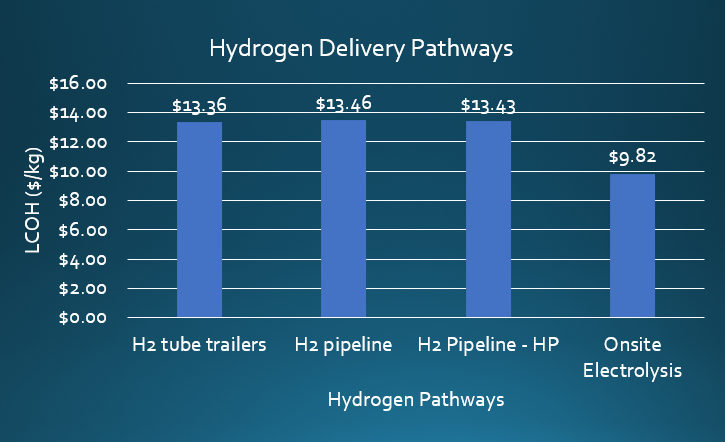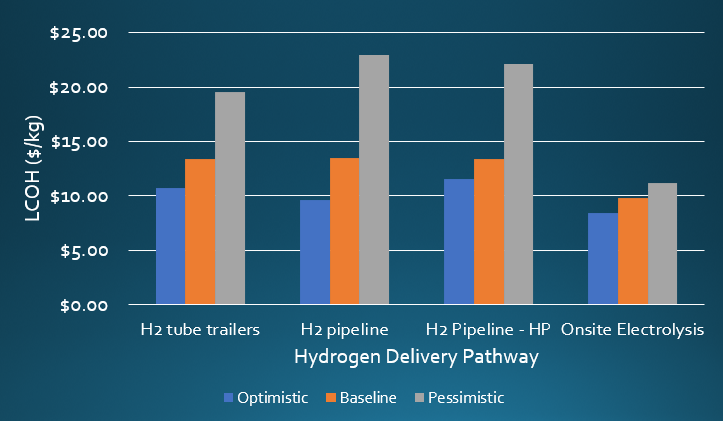Jason Lam, MEL Candidate | April 16, 2021
APPP 506 – Master of Engineering Leadership Capstone Project, University of British Columbia
Abstract
With countries around the world committing to net zero emissions by 2050, the question for how we should decarbonize our lives remains to be answered. One challenging area is the transportation of goods, as the large amount of space taken up and weight can affect the economic model for such goods. This capstone explores several hydrogen delivery pathways that could be used for creating the infrastructure for hydrogen powered long haul trucks. A levelized cost of hydrogen will be used to compare hydrogen distribution by tube trailer, hydrogen pipeline, and onsite hydrogen production, considering capital costs, operations and maintenance, and energy costs over the service life of the infrastructure. A sensitivity analysis will be used to determine the effect of fluctuating hydrogen production costs, hydrogen storage costs and hydrogen demand on the levelized cost of hydrogen. The goal of this capstone is to provide insight onto what pathways may be most economically efficient in establishing hydrogen infrastructure and determine what options could be applied for remote locations.
Introduction
Hydrogen fuel is one of the fuels considered for replacing oil and gas in vehicles. There are many properties of it which are appealing: it has a high energy content, emits zero carbon at point of use, can be used for combustion or in fuel cells. However, since it is an energy carrier an energy source like solar energy, biomass or hydrocarbons must be used to produce it. Depending on the method for producing energy, the hydrogen fuel can be produced with very low greenhouse gas emissions.
However it also faces many challenges as well. Hydrogen requires energy in order to be produced, and currently most hydrogen is produced by steam methane reformers, which produces greenhouse gas emissions. Transporting the hydrogen fuel is costly due to how the very low density of hydrogen gas, this makes it costly to store as it must be pressurized or liquefied prior to use. Along with that, there are always potential hazards with hydrogen’s high flammability, requiring extra precautions while transporting, storing, and using. Very high hydrogen purity is required for use in Fuel cell electric vehicles, requiring expensive purification or production processes to be used. Currently the majority of hydrogen is produced for industrial applications such as making ammonia for fertilizers or used in oil and gas operations.
Objectives
Hydrogen fuel may be a potential energy source where electrification, biofuels, carbon capture and storage are unable to efficiently replace fossil fuels. One such industry is for the shipping of goods, where weight, cargo volume, and down time are factors that can greatly affect the economics of shipping industries. The objective of this capstone project is to determine the possible hydrogen delivery pathways for fuel cell electric vehicles utilized for long haul road transport.
A comparison of the following hydrogen delivery pathways will be conducted:
- Distribution of hydrogen by hydrogen tube trailers
- Distribution of hydrogen by hydrogen pipeline
- Onsite hydrogen production via electrolysis at fuel station
Methodology
A levelized cost of hydrogen will be conducted using the following formula:

The useful life will be dependent on the hydrogen delivery pathway analysed while a discount rate of 15% is assumed for this study. The annual O&M costs are calculated from using 4% of the capital costs of the infrastructure required at the hydrogen refuelling station or for the transportation method. All of the referenced costs will be converted to 2020 Canadian dollars.

Source: wikipedia
The hydrogen scenario we will be looking at is providing hydrogen refueling infrastructure for long haul trucking along the TransCanada highway in BC. Some key assumptions we will be making for our calculations are as follows:
- Trans Canada highway length = 1,109 km
- Fuel Station spacing = 48 km
- FCEV vehicle penetration = 30%
- Average distance traveled = 63,428 miles
- FCEV truck fuel economy = 8.72 miles/kg H2
- Annual Hydrogen Fuel consumption = 68,839,684 kg H2/year
- Required Fuel station capacity = 9,583 kg/day
Results and Discussion
Levelized Cost of Hydrogen

The results of the analysis are shown in Figure 1. The figure shows that for long distance hydrogen distribution, the cost of using hydrogen tube trailers, hydrogen pipelines are approximately the same. While there is a lower LCOH for onsite hydrogen production with electrolysis. We can see from this analysis that onsite hydrogen production may be a possible hydrogen delivery pathway for remote communities as the LCOH is significantly lower.

The breakdown of the levelized cost of hydrogen is present in Figure 2 of each pathway. The cost of energy and the fuel station are large components for tube trailers, while the hydrogen pipeline is dominated by the capital expenditures from pipeline. The high pressure pipeline has reduced costs for the fuel station due to not requiring hydrogen compression or storage but the cost of energy to achieve the high pipeline pressure makes the LCOH roughly the same. The onsite electrolysis is largely dominated by the cost of electricity used for production suggesting that with cheaper sources of electricity the LCOH could be lowered.
Sensitivity Analysis

In the Sensitivity analysis the cost of hydrogen production, hydrogen storage, and hydrogen demand were adjusted to see the impact on the LCOH in this scenario. The cost of hydrogen production and storage were decreased while hydrogen demand was increased in the optimistic scenario while the opposite was done for the pessimistic scenario.
Policy Options
Some policy options have been looked at in literature and have examined the effects of the following policy options:
- Carbon tax
- Cap and Trade
- Capital Subsidies
- Low carbon fuel standards
For energy policy options that could help to lower the LCOH, some research has been done on financial incentives and market based policies. Research has found that production subsidies and electricity incentives were the most effective policies to facilitate low-carbon hydrogen production. Capital subsidies were found to often promote hydrogen production with Steam methane reformer and did not scale well with high demand scenarios. This policy findings matches the study here where the energy used for transportation or hydrogen production are large components of the LCOH.
Conclusion
We can conclude from this capstone that onsite hydrogen production with electrolysis has the lowest levelized cost of hydrogen out of the pathways examined. This leads us to conclude that using hydrogen delivery methods may not be the most economically efficient pathway for hydrogen distribution. The large distance required to be covered with a regular supply of hydrogen makes it very costly in terms of energy and capital expenditures required. It was generally seen that the cost of hydrogen production affected the LCOH the most in the sensitivity analysis. The onsite electrolysis could be a viable option for hydrogen production in remote areas as it has the advantage of not being as it can use off the grid energy resources and are able to provide Hydrogen fuel at a lower levelized cost than the delivered pathways.
Acknowledgements
 Mentor: Barbar Moawad, Navius Research Inc.
Mentor: Barbar Moawad, Navius Research Inc.
I would like to express my gratitude to my capstone mentor, Barbar Moawad for his mentorship, support and patience throughout this capstone project this term.
 Course instructor: Dr. Vladan Prodanovic, MEL CEEN Program Director
Course instructor: Dr. Vladan Prodanovic, MEL CEEN Program Director
I’d like to thank Dr. Vladan for organizing the course this term for part-time CEEN students and for providing me the opportunity to work with Navius Research
References
Antony, A., Maheshwari, N. K., & Rao, A. R. (2017). A generic methodology to evaluate economics of hydrogen production using energy from nuclear power plants. International Journal of Hydrogen Energy, 42(41), 25813-25823. 10.1016/j.ijhydene.2017.08.146
Cerniauskas, S., Jose Chavez Junco, A., Grube, T., Robinius, M., & Stolten, D. (2020). Options of natural gas pipeline reassignment for hydrogen: Cost assessment for a Germany case study. International Journal of Hydrogen Energy, 45(21), 12095-12107. 10.1016/j.ijhydene.2020.02.121
Cooley, H., Phurisamban, R., & Gleick, P. (2019). The cost of alternative urban water supply and efficiency options in California. Environmental Research Communications, 1(4), 42001. 10.1088/2515-7620/ab22ca
Demir, M. E., & Dincer, I. (2018). Cost assessment and evaluation of various hydrogen delivery scenarios. International Journal of Hydrogen Energy, 43(22), 10420-10430. 10.1016/j.ijhydene.2017.08.002
Gunawan, T. A., Singlitico, A., Blount, P., Burchill, J., Carton, J. G., & Monaghan, R. F. D. (2020). At What Cost Can Renewable Hydrogen Offset Fossil Fuel Use in Ireland’s Gas Network? Energies (Basel), 13(7), 1798. 10.3390/en13071798
Hecht, E. S., & Pratt, J. (2017). Comparison of conventional vs. modular hydrogen refueling stations, and on-site production vs. delivery. National Renewable Energy Laboratory https://www.energy.gov/eere/fuelcells/downloads/comparison-conventional-vs-modular-hydrogen-refueling-stations-and-site
Khzouz, M., Gkanas, E. I., Shao, J., Sher, F., Beherskyi, D., El-Kharouf, A., & Qubeissi, M. A. (2020). Life Cycle Costing Analysis: Tools and Applications for Determining Hydrogen Production Cost for Fuel Cell Vehicle Technology. Energies (Basel), 13(15), 3783. 10.3390/en13153783
Liu, N., Xie, F., Lin, Z., Jin, M., & Oak Ridge National Lab. (ORNL), Oak Ridge,TN (United States). (2019). Evaluating national hydrogen refueling infrastructure requirement and economic competitiveness of fuel cell electric long-haul trucks. Mitigation and Adaptation Strategies for Global Change, 25(3), 477-493. 10.1007/s11027-019-09896-z
Moreno-Blanco, J., Camacho, G., Valladares, F., & Aceves, S. M. (2020). The cold high-pressure approach to hydrogen delivery. International Journal of Hydrogen Energy, 45(51), 27369-27380. 10.1016/j.ijhydene.2020.07.030
Penev, M., Zuboy, J., Hunter, C., & National Renewable Energy Lab. (NREL), Golden,CO (United States). (2019). Economic analysis of a high-pressure urban pipeline concept (HyLine) for delivering hydrogen to retail fueling stations. Transportation Research.Part D, Transport and Environment, 77(C), 92-105. 10.1016/j.trd.2019.10.005
Reddi, K., Mintz, M., Elgowainy, A., & Sutherland, E. (2016). 13 – Building a hydrogen infrastructure in the United States. (pp. 293-319). Elsevier Ltd. 10.1016/B978-1-78242-364-5.00013-0
Reddi, K., Elgowainy, A., Rustagi, N., Gupta, E., & Argonne National Lab. (ANL), Argonne,IL (United States). (2017). Impact of hydrogen refueling configurations and market parameters on the refueling cost of hydrogen. International Journal of Hydrogen Energy, 42(34), 21855-21865. 10.1016/j.ijhydene.2017.05.122
Reddi, K., Elgowainy, A., Rustagi, N., Gupta, E., & Argonne National Lab. (ANL), Argonne,IL (United States). (2018). Techno-economic analysis of conventional and advanced high-pressure tube trailer configurations for compressed hydrogen gas transportation and refueling. International Journal of Hydrogen Energy, 43(9), 4428-4438. 10.1016/j.ijhydene.2018.01.049
Staffell, I., Scamman, D., Velazquez Abad, A., Balcombe, P., Dodds, P. E., Ekins, P., Shah, N., & Ward, K. R. (2019). The role of hydrogen and fuel cells in the global energy system. Energy & Environmental Science, 12(2), 463-491. 10.1039/c8ee01157e
Talebian, H., Herrera, O. E., & Mérida, W. (2021). Policy effectiveness on emissions and cost reduction for hydrogen supply chains: The case for British Columbia. International Journal of Hydrogen Energy, 46(1), 998-1011. 10.1016/j.ijhydene.2020.09.190
Talebian, H., Herrera, O. E., Tran, M., & Mérida, W. (2018). Electrification of road freight transport: Policy implications in British Columbia. Energy Policy, 115, 109-118. 10.1016/j.enpol.2018.01.004
Viktorsson, L., Heinonen, J., Skulason, J., & Unnthorsson, R. (2017). A Step towards the Hydrogen Economy—A Life Cycle Cost Analysis of A Hydrogen Refueling Station. Energies (Basel), 10(6), 763. 10.3390/en10060763
Yang, C., & Ogden, J. (2007). Determining the lowest-cost hydrogen delivery mode. International Journal of Hydrogen Energy, 32(2), 268-286. 10.1016/j.ijhydene.2006.05.009
Contact

jason.lam345@gmail.com
www.linkedin.com/in/jasonlam345/
Feel free to reach out to me by email or linkedin if you have any questions.